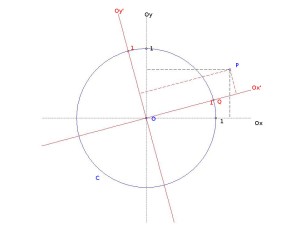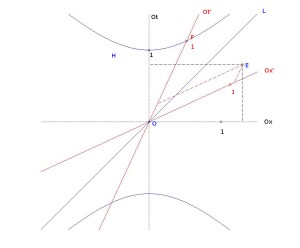I have read a little more on special relativity. I don’t have the time to write up a full proof of the basic formulas, and anyway there are plenty of places where one can find that. I would just like to explain a way to view geometrically the Lorentz transformation. I have learned about it in a book by Sanders Bais, Very Special Relativity: An Illustrated Guide. I’m sure its well known, as I recall seeing it in other books. But it is a really nice interpretation, and I want to try and explain it.
Planar rotations
First we look at a plane (see figure 1). We pick a point of origin , two orthogonal axis
and
and a unit of length. We have a Cartesian coordinate system. Let us consider a point
with coordinates
in this system. By turning the axis by an angle
, while keeping the same origin and the same unit, we obtain another coordinate system. The coordinates
of the point
in this new system are related to
by the formulas
Something to keep in mind: specifying the angle is the same as specifying the point
where the
-axis of the new system crosses the circle
.
Spacetime and frames of reference
The fundamental object in special relativity (according to H. Minkowski’s point of view) is the spacetime. It is the totality of events. One event is given simply by the time and and place at which it occurs. Now, an observer will find a way to associate coordinates to each event. She needs three space coordinates to define a position and one time coordinate to define a date (spacetime has four dimensions). To simplify, we will consider a model with only one spatial dimension. An event is therefore defined by the two coordinates given by the observer. I have represented this type of space time in the figure 2. The origin, the
-axis,
-axis and the units of time and length are the frame of reference of an observer. Here we choose the units so that the speed of light c is equal to 1. For example, if the unit of time is the second, the unit of length must be 299 792 458 meters.
Special relativity answers the question: ‘How are the coordinates that two observers associate to the same event related?’ To be more precise, assume that two observers and
both give the coordinates
to the same event (the origin). The observer
sees the observer
move with a velocity
. Another, more complicated, way of saying this: the set of all events where
is present (the worldline of
) is described by
with the coordinates
. Of course, the worldline of
is described by
with the coordinates
. Both worldlines are drawn on figure 2. I have also drawn the worldline of a flash of light moving to the right (
). With our choice of units,
has a slope
in the frame of
. Now let us consider an event
, given coordinates
by
. Let us call
the coordinates given by
to
. How are those coordinates related? The answer was given by Einstein in is famous 1905 paper On the electrodynamics of moving bodies:
This set of equations was actually discovered before by H. A. Lorentz. It is called the Lorentz transformation. It is derived by assuming that the laws of physics are the same for observers moving with constant velocity relative to one another, and that the speed of light is a universal constant (the same for all observers).
In the former kinematics (the one of Galileo and Newton), we could not say that two different events occurred at the same place, since two observers moving relative to one another would not agree on that. With the kinematics of Einstein, we cannot even say that two distant events occur at the same time. We see it on figure 2. From the point of view of , the
-axis contains all the events occurring at the same time as the origin. But from the point of view of
, all the events occurring at the same time as the origin are on the
-axis. Those two axis are distinct. Simultaneity is relative to the observer.
Geometry of the Minkowski transformation
If we look at figure 2, we see that the -axis of the observer
is simply the worldline of this observer. The
-axis is simply the symmetric of the
-axis with respect to the worldline of the flash of light. Since we know both axis, the job of building the frame of reference of
would be finished if we knew the units of time and of length. As we chose
, one unit is enough, let us say the unit of time. We must find the event
on the
-axis that is given time
by the observer
. We can of course find it with the help of the Lorentz transformation. But we can also note that
The event we are looking for is on the half-hyperbola that has equation
and is contained in the half plane
in the frame of reference of
. We find it at the intersection of
and the
-axis, as seen on figure 2.
Since does not appear in the equation of
, we can use
to construct the frame of reference of any moving observer. Assume
is a moving observer, with the same origin as
and
. We know its worldline, it is also its
-axis. Its
-axis is the symmetric with respect to the worldline of the flash of light. The intersection of the
-axis with
gives the time unit, and we find the space unit by symmetry.
Rapidity
At first, we have described the movement of , seen in the frame of
, by the velocity
. It is also the slope of the
-axis. But then we have seen another way to describe the movement of
: give the point
where its worldline crosses the half-hyperbola
. There is a third way. The curve
can be given by parametric equations, using the hyperbolic functions:
The point can be specified by a value
.
We can now write the Lorentz transformations with the parameter . We first write
and then, with a little hyperbolic trigonometry,
We get new expressions for the Lorentz transformation that look like an ‘hyperbolic rotation’:
The parameter is called the rapidity of
with respect to
.
Now consider a third observer moving with velocity
and rapidity
relative to
. By applying twice the transformation equations, and after using the addition formulas for the hyperbolic functions, we get, for the
coordinates (given by
), the very simple formulas
To compose rapidities, we just have to add them. If we try to compose velocities, on the other hand, the formula gets messy. We have to use the addition formula for the hyperbolic tangent
and we get the relativistic formula for the composition of velocities

